

That's right.
The diagnostic functions of today's motorcycles are evolving rapidly, and unlike in the past, it is becoming more important to read this data when performing maintenance.

So, on this page, I will explain what is OBD, DTC, and finally MCS, a Honda motorcycle-specific diagnostic system.
Index
1.What is OBD?
OBD (On-Board Diagnostics) is a self-diagnostic function installed in electronic control systems (e.g., PGM-FI* for Honda) governing automobiles and motorcycles.
The main roles of OBD are vehicle status monitoring, system error detection/recording and self-diagnosis, and compliance with emission regulations.
Currently, vehicles sold around the world are required to be equipped with OBD, and Honda motorcycles equipped with systems such as PGM-FI are also equipped with this OBD.
*PGM-FI (Programmed Fuel Injection) is an electronically controlled fuel injection system.
2.Types of OBD
OBD currently includes OBDⅠ, a standard that was introduced in the late 1980s and early 1990s, and OBDⅡ, which was introduced after the late 1990s and is now the mainstream standard.
OBDⅠ and OBDⅡ differ in their methods of monitoring vehicle status and self-diagnosis.
■ Main differences between OBDⅠ and OBDⅡ
| OBDⅠ | OBDⅡ | |
|---|---|---|
| Start | ・Automobiles: Late 1980s to around 1995 ・Motorcycles: From 2015 |
・Automobiles: From 1996 ・Motorcycles: From 2020 |
| Main Purpose |
Mainly engine-related failure detection | Enhanced emission control, more efficient maintenance, compliance with environmental regulations |
| Main Features |
Enables fault code readout and capturing partial vehicle information |
Enables fault code readout, enhanced self-diagnostic capabilities, and capturing more vehicle information |
| Diagnostic Connector |
Manufacturer-specific connector | Standardized 16-pin connector |
| DTC (Diagnostic Trouble Code) |
Manufacturer-specific specifications | ISO-defined international standards |
■ Example models equipped with OBDⅡ
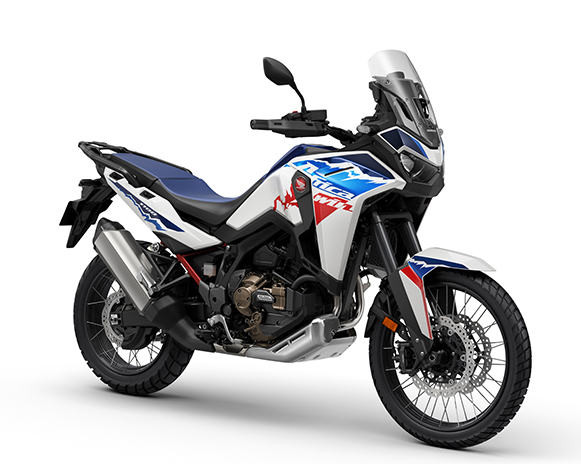
Africa Twin

ACTIVA125

Does having OBDⅡ mean that you can diagnose faults more quickly and accurately?

That's right.
This makes it possible for the maintenance staff to fix problems more quickly and accurately.
It results in peace of mind for customers.

Next, let's hear what is DTC?
3.What is DTC?
DTC (Diagnostic Trouble Code) is a failure code that specifies an abnormality detected by the computer (ECU) onboard the vehicle. Since OBDⅡ was introduced, the code system has been internationally standardized and DTCs are common to all manufacturers.
4.DTC Structure
A DTC consists of five characters (one alphabet letter and four digits) and is classified as follows.
■ Example of an OBDⅡ DTC
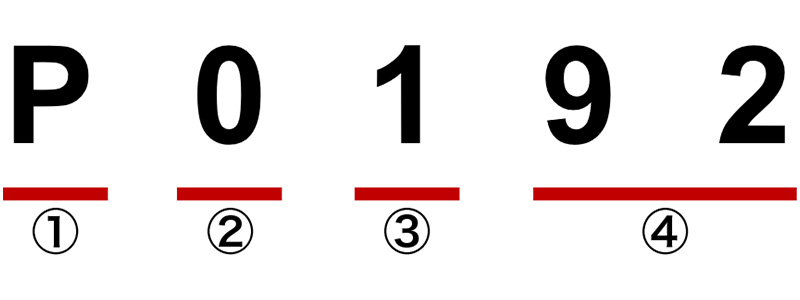
①System where failure is being experienced
P: Powertrain (Engine, Transmission, etc.)
B: Body (Airbags, Seatbelts, etc.)
C: Chassis (Brakes, ABS, etc.)
U: Communication Network (CAN communication, etc.)
②Type of failure
E.g., General or manufacturer-specific failure
③Major classification, including failure location and system details
Ex: Fuel injection system failure
④Specific failure detail
Ex: Low sensor circuit voltage

By correctly reading DTC, you can avoid unnecessary disassembly or part replacements,
saving both time and money. It also reduces potential damage to the vehicle caused by unnecessary work.

That makes sense!
How do you read a DTC?

There are two ways to read a DTC.
Method ①: Use a scan tool to read the codes directly
Method ②: Read the flashing pattern of the PGM-FI malfunction indicator lamp (simple diagnosis)
Do note that the ②PGM-FI malfunction indicator lamp flashing function has been discontinued for vehicles equipped with OBDⅡ.


Even if the vehicle has a ②PGM-FI malfunction indicator lamp that flashes DTC, it’s only meant for emergency or temporary checks.
If you miss the flashes even once, or miscount them, you might not get the correct information.
That’s why ①using a scan tool is still the most accurate and reliable way to read DTCs.

There are general-purpose scan tools on the market, but the tool specifically for Honda motorcycles is called MCS.
5.What is MCS?
MCS (Motorcycle Communication System) is a dedicated diagnostic tool developed by Honda to perform fast and accurate diagnostics on Honda motorcycles.
By using MCS, technicians can check the operating status of electronic control systems—such as PGM-FI—that are not visible to the eye, as well as view DTCs.
This makes it easier to assess the vehicle’s condition during maintenance and to isolate fault areas when troubleshooting issues.
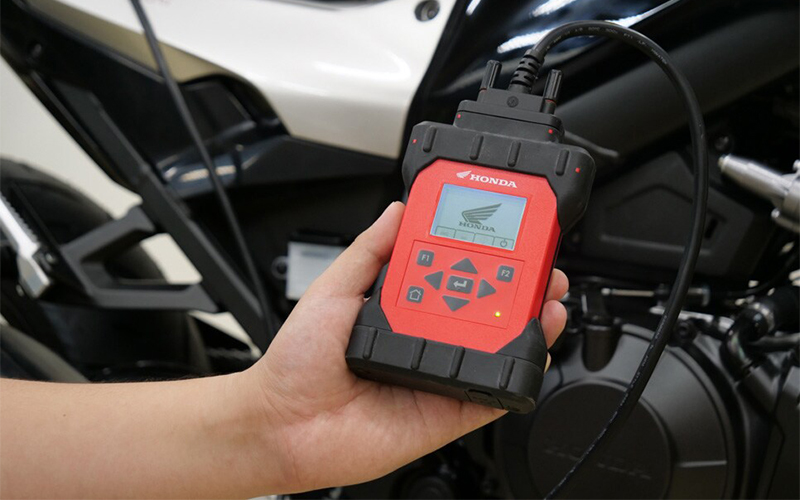
6.Key MCS Functions
MCS has a variety of functions that are useful during maintenance and failure diagnosis, including the following main functions.
- Quick Doctor Function
- View/Save and Clear DTCs
- List Data
- View Data
- Freeze Data
- Drive Recorder
- Reset ECU
- Update ECU
One of its key features, "Quick Doctor" allows for a rapid check of the motorcycle’s condition during maintenance and other routine inspections.
■ Example: Display screen in various normal conditions
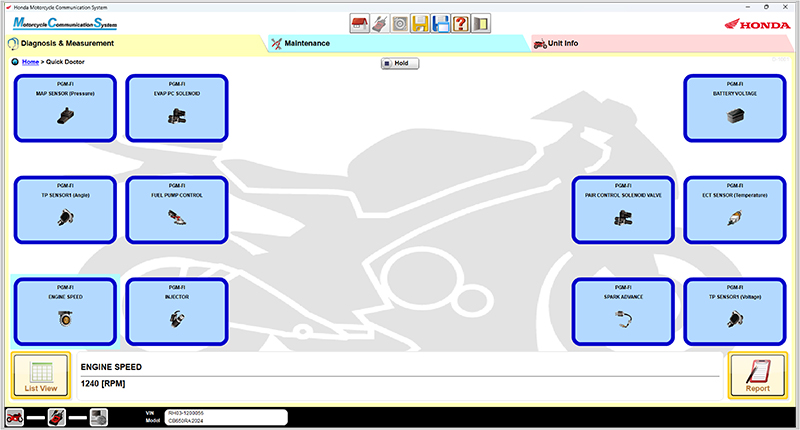
■ Example: Display screen when there is a problem with various items (frame is red)
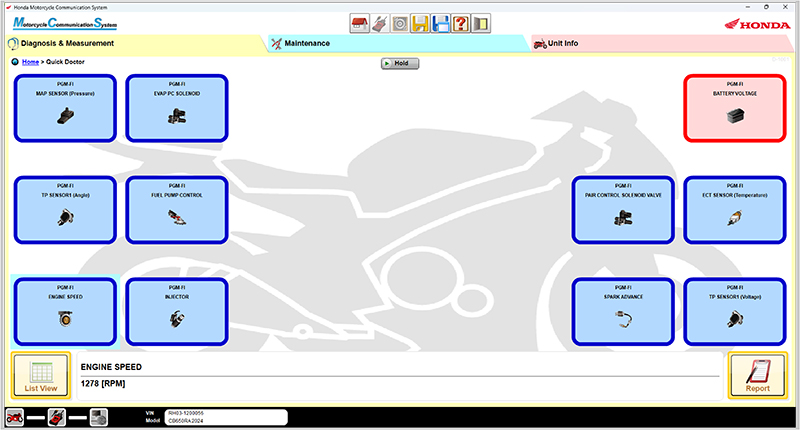
■ Example: Quick Doctor Report
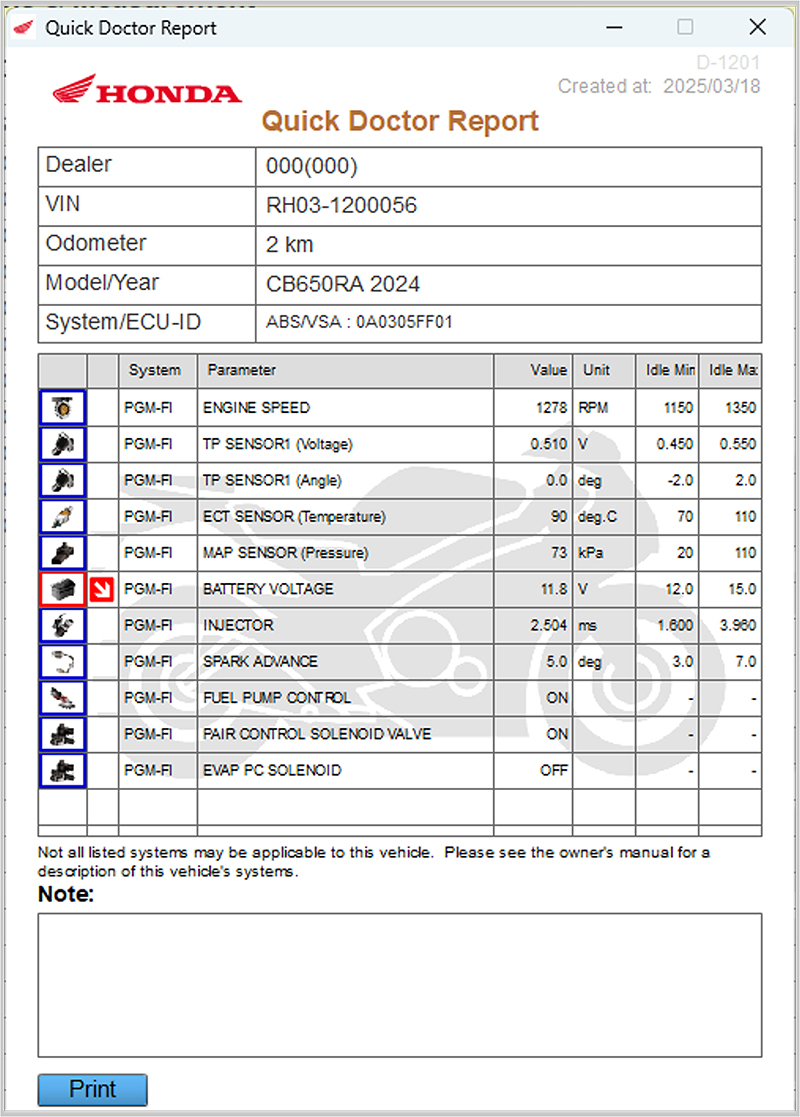

So this is how the report comes out!

Maybe I’ll stop by a Honda dealer and get a Quick Doctor check—just a little health check for my motorcycle.

But now I’m curious… what’s the difference between MCS and those generic scan tools you can buy?
7.Differences Between MCS and Generic Scan Tool
Generic scan tools (GSTs) are commercially available, but conversion adapters may be required if the connection port shape or communication protocol does not match.
In addition, while GSTs are basically only capable of diagnosing and monitoring emission-related PGM-FI ECUs, MCS can diagnose, monitor, rewrite, and reset all ECUs for all Honda vehicles.
■ Comparison table: MCS vs. GSTs
| MCS | GSTs | |
|---|---|---|
| ECU being diagnosed | All ECUs are supported (PGM-FI, ABS, DCT, EV-related systems, and others) |
Only emission-related ECUs (PGM-FI) |
| Functions |
|
*Limited to emission-related items only |
| Diagnostic connector | ✔ Direct connection | ⚠ May require adapter |

That’s why we recommend using MCS for reliable diagnostics and proper maintenance of Honda motorcycles.
As a warning to the rider, when a DTC is detected, a warning light will illuminate on the meter to inform the rider that the bike is detecting an abnormality.
See the article below for more information.

But if you see a warning light on the meter, do not try to diagnose it yourself.
Instead, have it diagnosed by Honda dealer!
8.Conclusion
For diagnosing Honda motorcycles, the Honda-specific MCS is still the best diagnostic device.
MCS can capture detailed vehicle information and anomalies that cannot be checked with generic scanning tools.
Even during regular inspections and maintenance, Honda authorized dealers themselves use MCS to carefully check vehicles.
For the health check of your beloved vehicle, go with the Honda-specific tool!
To continue riding your Honda motorcycle with peace of mind, please visit your local dealer.
■ Reference: Past article on MCS (Motorcycle Communication System):
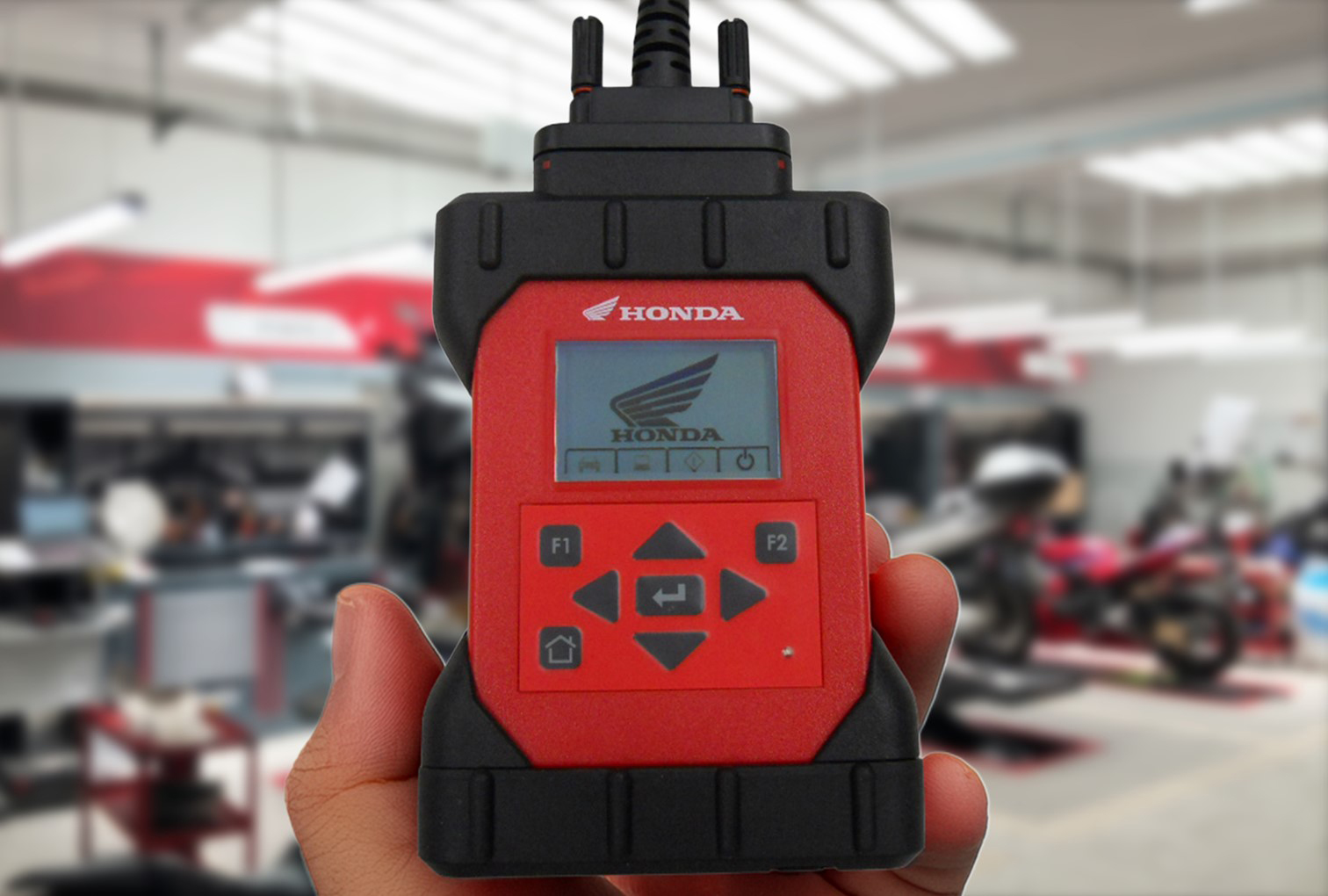


I feel like there are a lot of new terms being thrown around about motorcycles, like "OBD" and "DTC."